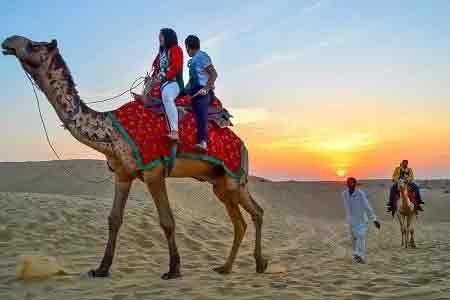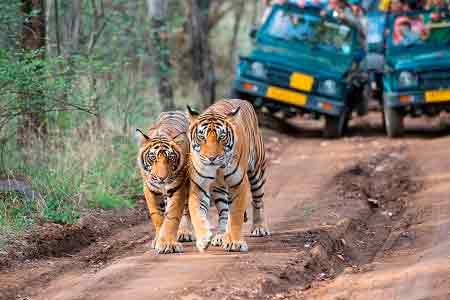

Pushkar is a town in the Ajmer district in the Indian state of Rajasthan. It is situated about 10 km (6.2 mi) northwest of Ajmer and about 150 kilometres (93 mi) southwest of Jaipur. It is a pilgrimage site for Hindus and Sikhs. Pushkar has many temples. Most of the temples and ghats in Pushkar are from the 18th century and later, because many temples were destroyed during Muslim conquests in the area. Subsequently, the destroyed temples were rebuilt. The most famous among Pushkar temples is the red spired Brahma Temple built during the 14th century CE. . It is considered a sacred city by the Hindus particularly in Shaktism, and meat and eggs consumption are forbidden in the city. Pushkar is located on the shore of Pushkar Lake, which has many ghats where pilgrims bathe.Pushkar is also significant for its Gurdwaras for Guru Nanak and Guru Gobind Singh. One of the bathing ghats is called Gobind ghat built by the Marathas in the memory of Guru Gobind Singh.
Pushkar Lake
According to Hindu scriptures, the sacred Pushkar Lake is described as ‘Tirtha Raj’, the king of all pilgrimage sites. No pilgrimage is considered to be complete without a dip in in the holy Pushkar Lake. Semi-circular in shape and about 8-10 metres deep, Pushkar Lake is surrounded by 52 bathing ghats and over 400 temples and is truly a magnificent sight to behold.
Brahma temple
Nestled in the picturesque Pushkar valley beyond the Nangaparvat and Anasagar Lake, the Brahma temple holds a special place in the hearts of Indians. It is the only temple in the world dedicated to Lord Brahma. Built with marble and decorated with silver coins, this temple can be identified by its red spire and the image of a swan (considered sacred to Lord Brahma). The chaturmukhi (four faced) idol of Lord Brahma is housed in the inner sanctum. A marble statue of the sun god stands sentinel at the temple. Interestingly, while all the gods are shown bare footed, Surya is shown wearing ancient warrior’s boots.
Gurudwara Singh Sabha
Gurudwara Singh Sabha, situated in the eastern part of Pushkar, was built in the beginning of the 19th century to commemorate the visits of the first and the tenth gurus- Guru Nanak Dev and Guru Govind Singhji.
Varaha temple
Varaha temple is the largest and the most ancient temple of Pushkar. Constructed by the 12th century ruler, King Anaji Chauhan, this temple is dedicated to the third incarnation of Lord Vishnu as a wild boar. Legend has it that Varaha rescued the earth from depth of the primeval water, where it was dragged down by a demon (Hirnayaksh). It is one of the most visited temples in Pushkar.
Savitri Temple
Dedicated to Lord Brahma's first wife, Goddess Savitri, this temple is situated on a hillock right behind the Brahma temple. While climbing the long series of steps leading to the temple, one can catch a panoramic view of the lake, surrounding temples and sand dunes. The presence of the only Brahma Temple in Pushkar is the outcome of Savitri’s curse to Brahma for marrying another Goddess, Gayatri, while starting his yagna in Pushkar.
Rangji Temple
The gracious and conspicuous Rangji Temple is another popular shrine that witnesses thousands of pilgrims and tourists every year. The temple is dedicated to Lord Rangji, believed to be an incarnation of Lord Vishnu. The influence of South Indian style, Rajput style and Mughal style in the temple’s architecture is highly noticeable. The high-rising ‘Gopuram’, prevalent mainly in the temples present in South India is another feature of the temple that attracts visitors.
Atmateshwar Temple
This beautiful 12th century temple is dedicated to Lord Shiva and has an underground component. The intricate Hemadpanti architectural style carvings give this temple a magnificent appearance. Thousands of devotees flock here to pay their respects during the auspicious time of Shivaratri, when Lord Shiva is ritually respected.
Man Mahal
The Man Mahal is one of the greatest palaces of Pushkar. Built as a guest house of Raja Man Singh I, this palace is one of the most attractive spots to visit in Pushkar. It was built to serve as a royal guest house for Raja Man Singh I. The Rajasthani architecture from the royal era that adorns the palace makes it a visual treat. It has now been converted into a heritage hotel, called the RTDC Hotel Sarovar, and allows tourists to not only enjoy the beauty of the palace but also the breathtaking view of the lakes and temples around the lake.




































Rajasthan Tour Packages are arguably the most sought after holiday packages in India. The very name Rajasthan conjures up the image of hill top fortresses, maharajas with scimitars riding the painted elephants, the exquisitely carved havelis. Our Rajasthan tour packages the camel safari in the sam sand dunes of Thar in Jaisalmer and Bikaner to the abundant wildlife of Ranthambore and Bharatpur, Explore the World Heritage Hill Forts of Rajasthan, marvel at the frescoes and havelis, have a wild run at Ranthambore or shop till you drop at the vibrant bazaars in Jaipur, Jodhpur and Udaipur and not to mention the planets biggest cattle fair in Pushkar.